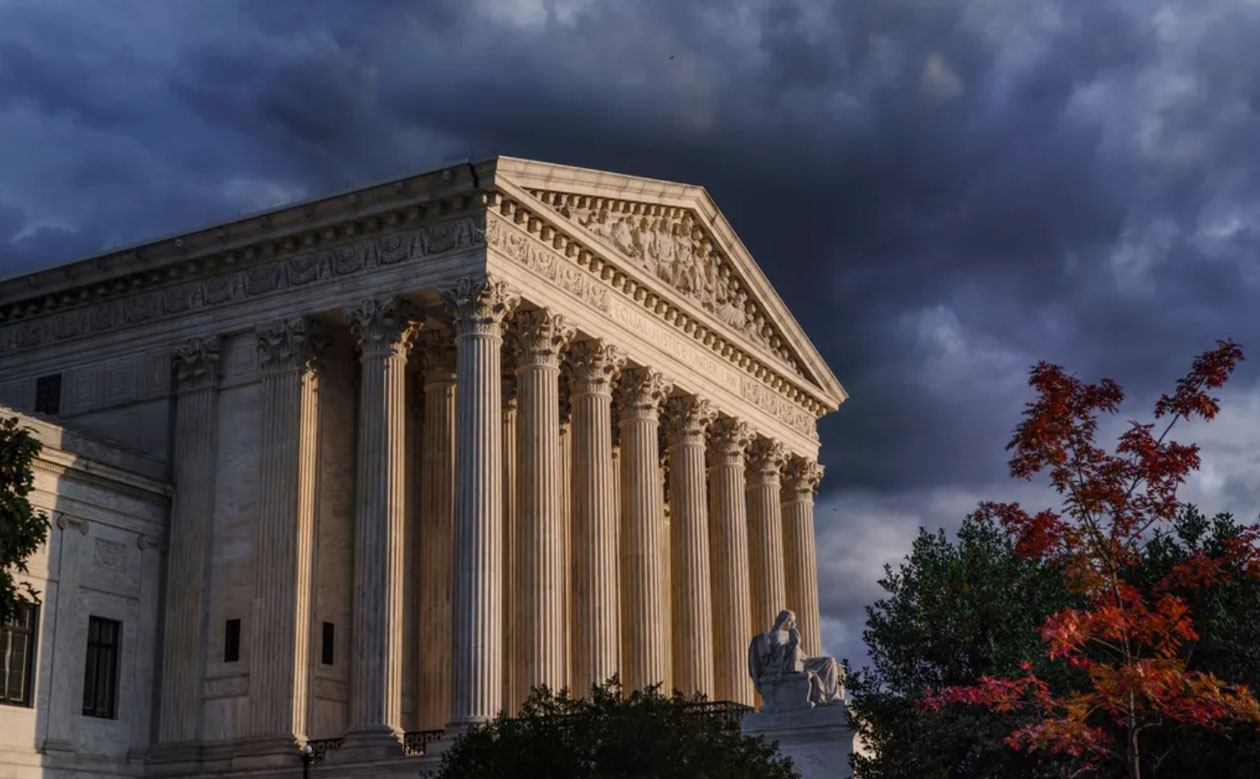
WASHINGTON —In a complex case from Washington state, the right-wing dominated U.S. Supreme Court tackled the right to strike and whether corporate lawsuits can stop it.
“The right to strike is on trial today at the U.S. Supreme Court,” AFL-CIO President Liz Shuler warned in a Jan. 10 tweet about the case, Glacier Northwest, Inc. v Teamsters Local 174. “For nearly a century, federal law has protected workers’ right to strike in order to improve their wages, hours and working conditions.”
Now that right is under threat from the corporate class and the radical right—at least as shown by a long line of friend-of-the-court briefs from conservative legal groups and political lobbies. In the case, they seek another weapon against unions: After-the-fact lawsuits for cash.
The story is so convoluted that progressive justices Elena Kagan, Sonia Sotomayor and Ketanji Brown Jackson handled most of the questioning of the attorneys for both sides, and of President Joe Biden’s Justice Department, which was officially neutral.
The issue, as laid out in the hour-and-a-half session, is who can rule whether a strike is legal or not, whether the union can be sued afterwards for damages, and if the National Labor Relations Act, as a federal law governing labor vs management, pre-empts such court cases.
The National Labor Relations Board said the 11-day strike Local 174 carried out was legal. After Glacier and Local 174 settled, Glacier sued the union for allegedly letting members disable its cement mixers by letting cement dry within the non-rotating barrels on each truck.
The Washington State Supreme Court tossed Glacier’s suit. Meanwhile, the National Labor Relations Board filed a labor law-breaking complaint against Glacier, making the strike legal. Glacier took its loss in the state court all the way to D.C., seeking the right to sue—and for it and the rest of the corporate class to cripple unions financially with that threat.
“Glacier sued Local 174 over a concerted work stoppage”—the strike—”conduct at the heart of” labor law’s “protections. Under settled law, strikers lose those protections if they fail to take reasonable precautions to avoid aggravated, imminent, foreseeable harm to employer property,” said Seattle attorney Darrin Dalmat, defending the union and the right to strike.
“Applying that test, the board never found a forfeiture” of the right to strike “merely because perishables spoil,” Dalmat said of the cement in the trucks. It didn’t spoil. Glacier admitted that in documents filed with the justices.
If Glacier Northwest wins the right to sue, after the fact, its victory opens the way to similar lawsuits by firms against unions nationwide for alleged “property damage” by strikers. Such suits can break union finances and thus endanger the right to strike.
That’s what Glacier Northwest and its right wing and corporate backers want.
“Frankly, we’d prefer not to be before an administrative agency”—the NLRB—”where the agency is the judge, jury, and executioner,” and can penalize labor law-breakers, said former Republican Solicitor General Neal Francisco, arguing for Glacier. “We prefer to be in a court system where we have a–a–a neutral judge and the potential for a jury.”
Overwhelmed by political pressure
Left unsaid by Francisco, now a top lawyer at notorious union-buster Jones Day: State courts, including supreme courts, are often overwhelmed by political pressure, since many of those judges are elected. Knowing that, Republicans have, for at least a decade, pumped millions of dollars into electing pro-corporate and right-wing state and local judges.
They’ve also continually lambasted “unelected bureaucrats” in D.C., a favorite GOP political piñata, including the NLRB’s staff. And in 1995, the GOP approved legislation to let Congress permanently outlaw specific federal rules. Its first target? OSHA’s ergonomics rule.
Local 174’s lawyer, Dalmat, said the NLRB is the right place for the Glacier case. He also reiterated the Washington Supreme Court tossed Glacier’s damage suit against the union.
“These pleaded facts show reasonable precautions” by the union to prevent damage, said Dalmat. “At a minimum, there’s enough evidence in the record to allow the board lawfully…to rule in our favor. And that’s all” a past Supreme Court ruling “requires to oust state court jurisdiction temporarily, as the Washington Supreme Court” did.
“Now that the board has taken up the case and exercised its primary jurisdiction over this labor dispute, the grounds” for the justices to side with the union “are even clearer.”
Justices Sotomayor, Kagan and Jackson challenged corporate attorney Francisco.
“If an employee goes on strike, their duty to you has ended,” Justice Sotomayor said. “I can walk by your plant and the parking lot and see those trucks running. I have no obligation to tell you there’s cement in there. I have no obligation to move the truck. I have no obligation to do anything… The property (the cement) is perishing on its own.”
“The employees took affirmative action, the union took affirmative action to put the product in a vulnerable position precisely so they could abandon it to spoil,” Francisco countered. The trial record shows the drivers, when they struck, left the trucks running so the cement would stay liquified. Even Glacier admitted it.
“What I hear you saying is the focus on intent is wrong because workers, unions, do things all the time intentionally to maximize economic harm,” Justice Jackson told Local 174’s attorney, Dalmat. “You know, that if there’s a seasonal component of a business, workers will try to time their strike in order to maximize the economic harm because more of the business is conducted in the summer than in the winter, things like that, that there are all kinds of things which are perfectly intentional to maximize economic harm.
“And so you’re saying that when we start focusing on intent without more, it pulls in pretty much, you know, every strategic decision that a union makes as to when to conduct a work stoppage,” the justice added.
“That’s absolutely right,” Dalmat agreed.
The justices will decide the case by the end of this court term, June 3.










